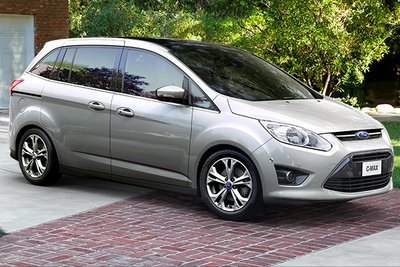Ford introduced and displayed a US market version of the European-market Grand C-Max at US auto shows in early 2011. By June 2011, Ford had abandoned plans to introduce the seven passenger version. This move was to allow Ford to increase production plans for the five-passenger gasoline/electric hybrid and dedicated electric models due in 2012. Our original summary text follows: Over time, each new generation of vehicles grow in size and content. In the US market, family vehicles have steadily grown from the original minivan to today's comparatively larger minivans and behemoth SUVs. Like the Mazda5, the Ford C-Max addresses the need for fuel-efficient and inexpensive vehicles that can carry more than five passengers. The C-Max can seat three passengers in the second row, and two passengers in the third row. A large sliding side door eases access to the third row. Since the C-Max is front-wheel-drive, the floor is low and there is a surprising amount of legroom in the third row. The lightweight seats fold flat for easy cargo hauling and the taller profile and larger hatch provide up to 70 cubic feet of capacity for larger items. Ford equips the C-Max with two different four-cylinder engines. The C-Max is offered with a variety of upscale features like a panoramic sunroof and Ford's popular Sync system. One unique feature allows a driver carrying the key to open the rear hatch by waving their leg near the rear bumper.
What Changed:
The new Ford C-Max is a smaller 7-passenger vehicle with sliding rear doors. The C-Max is powered by either a 2.5l four-cylinder or a turbocharged 1.6l four-cylinder. Both engines have similar output and are mated to a standard six-speed automatic transmission. The 7-passenger C-Max is related to the Grand C-Max that is sold in Europe.
| Model/Trim/Package | Engine | Original MSRP | ||
|---|---|---|---|---|
| C-Max 2.5 | 2.5l I4 (168-bhp) | A6 | FWD | TBD |
| C-Max 1.6 | 1.6l I4 T (168-bhp) | A6 | FWD | TBD |

